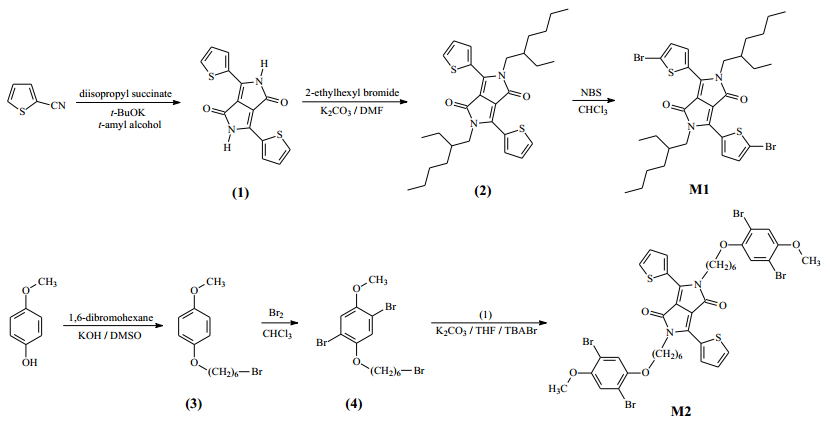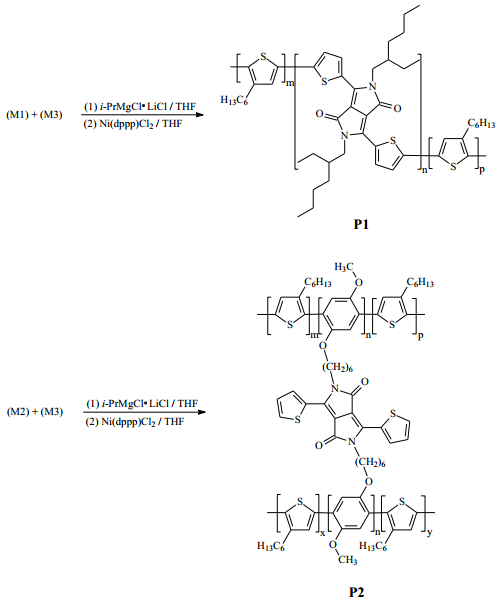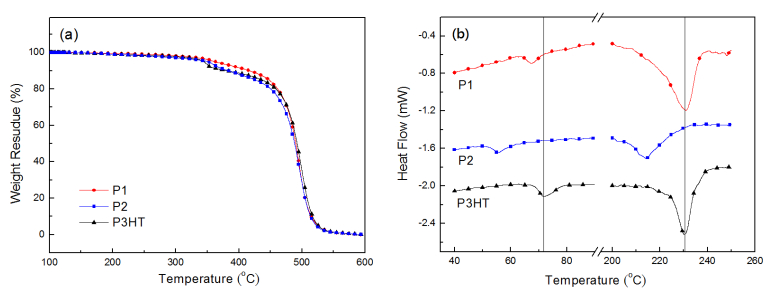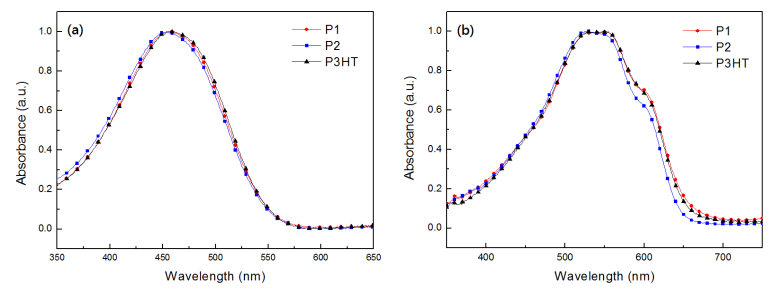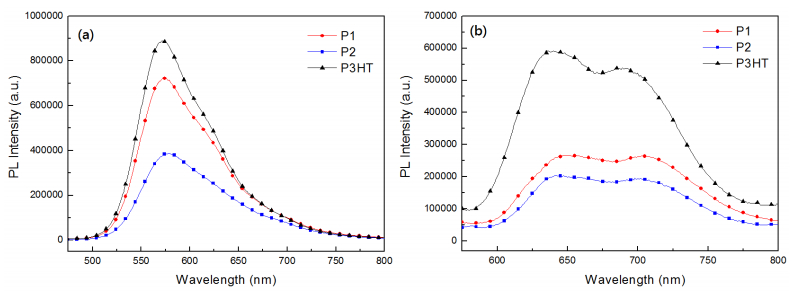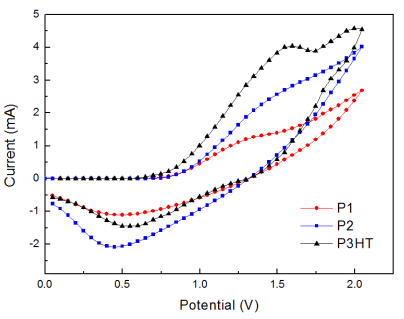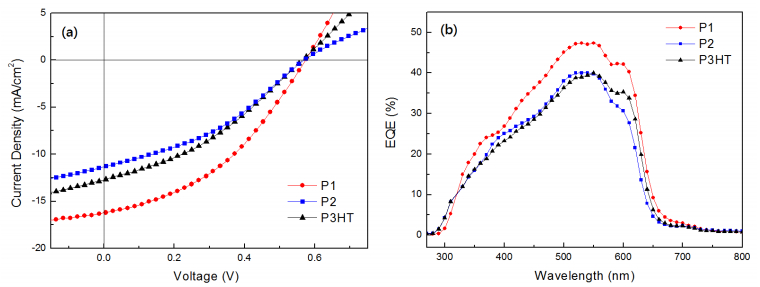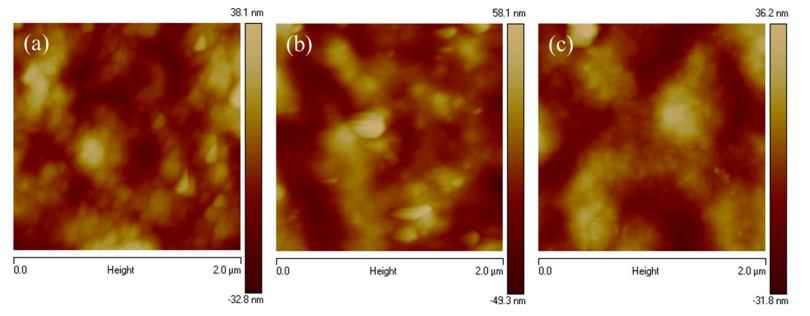Two novel polythiophene derivatives with linear or hyperbranched architectures using diketopyrrolopyrrole (DPP) as linking groups as well as normal poly(3-hexylthiophene) (P3HT) were synthesized via the Universal Grignard metathesis polymerization. The molecular weights of the linear polythiophene containing DPP linking moieties are higher than those of P3HT, while molecular weights of the hyperbranched one are smaller. The main decomposition temperatures of polymers were measured at 470 °C from TGA experiments. The UV-vis absorption behaviors of the DPP-containing polymers are similar to that of P3HT; moreover, these DPP-containing polythiophenes show distinct PL decay both in solution and thin film states. The electrochemical experiments reveal that the incorporation of DPP groups resulted in lowering HOMO levels of polymers. All polymers were blended with PC61BM and used as active layers for the fabrication of inverted polymer solar cells. The power conversion efficiency of devices based on linear and hyperbranched polythiophenes reached 3.74% and 2.38%, respectively, revealing comparable or even higher efficiency than the one based on normal P3HT.
1.
Introduction
To evaluate a lot of genuine life troubles, MADM is the most dominant and feasible procedure from the decision-making strategy to survive with intricate data in authentic life scenarios. Under the beneficial processes of MADM conception, a lot of people have employed it in the circumstance of diverse territories. But, to accomplish with more than two sorts of opinions, Zadeh [1] firstly invented such sort of idea which includes more than two sorts of opinions in the shape of truth grade (TG) is called fuzzy set (FS). A large number of scholars have modified the conception of FS were to present the intuitionistic FS (IFS) [2], soft set (SS) [3], N-SS [4], fuzzy N-SS [5,6], Hesitant N-SS [7], bipolar valued FS (BFS) [8] and bipolar SS (BSS) [9]. All these theories have their importance but IFS proves to be a valuable procedure to convey the awkward fuzzy knowledge because it has TG TCfif(b) and falsity grade (FG) FCfif(b), with 0≤TCfif(b)+FCfif(b)≤1. Further, Yager [10] diagnosed another well-known conception of Pythagorean FS (PFS), with a valuable technique 0≤T2Cfpf(b)+F2Cfpf(b)≤1. Some implementations have been invented by distinct peoples likewise, correlation coefficient [11], different sort of methods [12], Pythagorean m-polar FSs [13], TOPSIS methods [14], and Chebyshev measure [15] by using the PFSs.
The conception of FS was extended by Ramot et al. [16]. They initiated the technique of complex FS (CFS), signifying TG TCfcp(b)=TCfRT(b)ei2π(TCfIT(b)), with TCfRT(b),TCfIT(b)∈[0,1]. But in a lot of scenarios, they are unable to identify real-life dilemmas. In that spot, the complex IFS (CIFS), invented by Alkouri and Salleh [17]. CIFS includes the TG TCfcp(b)=TCfRT(b)ei2π(TCfIT(b)) and FG FCfcp(b)=FCfRT(b)ei2π(FCfIT(b)), with 0≤TCfRT(b)+FCfRT(b)≤1,0≤TCfIT(b)+FCfIT(b)≤1. Several modifications are illustrated here: for instance, CIF classes [18], CIF graph [19], CIF soft sets [20], CIF aggregation operators (AOs) [21], CIF quaternion number [22], CIF group [23], CIF algebraic structure [24]. Further, Ullah et al. [25] diagnosed the complex PFS (CPFS), which includes a new well-known strategy in the shape 0≤T2CfRT(b)+F2CfRT(b)≤1,0≤T2CfIT(b)+F2CfIT(b)≤1. A lot of applications have been employed by Akram and Naz [26], Akram and Sattar [27], Akram et al. [28], Ma et al. [29], Akram and Khan [30], and Garg [31].
IFSs, PFSs, CIFSs, and CPFSs have achieved a lot of well-wishes from the side of scholars under the very well-known techniques of all prevailing conceptions. The distinct sort of implementations are stated in the shape: geometric AOs for IFSs [32], Hamacher AOs for IFSs [33], frank power AOs for IFSs [34], Heronian AOs for IFSs [35], Harmonic AOs for IFSs [36], Bonferroni AOs for IFSs [37], Prioritized AOs for IFSs [38], Power AOs for IFSs [39], Maclaurin symmetric mean for IFSs [40], AOs for PFSs [41], Einstein AOs for PFSs [42], Hamacher AOs for PFSs [43], Choquet frank AOs for PFSs [44], Heronian AOs for IFSs [45], Bonferroni AOs for PFSs [46], Prioritized AOs for PFSs [47], Power AOs for IFSs [48], Maclaurin symmetric mean for PFSs [49]. Under the above circumstances, a decision-making strategy always includes a lot of major hurdles as:
1) How to demonstrate the data on the appropriate procedures to clarify the data.
2) How to calculate the distinct attribute objects and arrange the generally favorite quantity.
3) How to study the beneficial ideal from a lot of collections in the shape of alternatives.
Hence, the major contribution of the theme is to invent the beneficial decision-making strategy under CPFSs by using the AOs for CLs. The prevailing conceptions are the specific parts of the invented CPFSs under implementing the distinct sort techniques. In CPFS, the intellectual faced two sorts of theory in the shape of real and unreal terms, which can help to decision-maker for taking a beneficial decision. But the prevailing IFSs, PFSs have a grip on one aspect at a time due to their weak mathematical structure. The unreal terms have been completely missed in these two ideas and due to these issues, the decision-maker loses a lot of data during the decision-making procedure. The importance of the unreal term in CPFS is that if an expert wants to lunch the car enterprise based on the well-known considerations in the shape of its name of the car and production dates. Here, the name of the car shows the real part, and the production of the car date shows the unreal part. For managing with such sort of scenario, the technique of IFS and PFS has been unsuccessful. For this, we consider the well-known conception of CPFS to try to demonstrate the beneficial results. The key factors of the invented works are implemented in the shape:
1) To analyze some new operational laws based on CLs for CPF setting.
2) To demonstrate the concept of CCPFWA, CCPFOWA, CCPFWG, and CCPFOWG operators are invented.
3) Several significant features of the invented works are also diagnosed.
4) To investigate the beneficial optimal from a large number of alternatives, a MADM analysis is analyzed based on CPF data. A lot of examples are demonstrated based on invented works to evaluate the supremacy and ability of the initiated works.
5) To identify the sensitive analysis and merits of the invented works with the help of comparative analysis and they're graphical shown.
The sensitive analysis of the prevailing and proposed works is diagnosed in the shape of Table 1.
In Table 1, we easily get that the symbol " √ " stated the operators were developed someone and the symbol ×, stated the operators cannot be developed by anyone up to date. We know that the conception of CPFS is very well-known and interesting, but up to date, no one has employed it in the region of any sorts of operators to investigate the feasibility and consistency of the invented works. For more convenience, we illustrated Figure 1, which stated the invented works.
Lastly, the main characteristics of the CPFSs under a lot of points are illustrated in Table 2.
Likewise, a narrative MADM process in the viewpoint of these recommended operators is constructed in which rankings are characterized in conditions of CPFNs. The feasibility down with the prevalence of methodology is illustrated over a genuine-life mathematical statistic and verified by differing their results with many prevalent approaches.
This analysis is constructed in the shape: Section 2 includes some prevailing concepts of CPFSs and their related properties. Section 3 includes analyzing some new operational laws based on CLs for the CPF setting. Moreover, to demonstrate the closeness between finite numbers of alternatives, the conception of CCPFWA, CCPFOWA, CCPFWG, and CCPFOWG operators are invented. Several significant features of the invented works are also diagnosed. Section 4 investigates the beneficial optimal from a large number of alternatives, a MADM analysis is analyzed based on CPF data. A lot of examples are demonstrated based on invented works to evaluate the supremacy and ability of the initiated works. For massive convenience, the sensitivity analysis and merits of the identified works are also explored with the help of comparative analysis and they're graphically shown. The conclusion is referred to in Section 5.
2.
Preliminaries
Several prevailing studies under the CIFSs, CPFSs, and their related properties. The mathematical symbol Uuni, diagnosed the universal set with TG and FG in the shape: TCfcp(b)=TCfRT(b)ei2π(TCfIT(b)) and FCfcp(b)=FCfRT(b)ei2π(FCfIT(b)). For the convenience of the reader, here we reviewed the conception of CIFSs, initiated by Alkouri and Salleh [17].
2.1. CIFS and their laws
Definition 1. [17] A mathematical structure of CIFSs Cfci, diagnosed by:
With a well-known characteristic 0≤TCfRT(b)+FCfRT(b)≤1 and 0≤TCfIT(b)+FCfIT(b)≤1. The mathematical shape of CIFN is diagnosed by: Cfcp−j=(TCfRT−j(b)ei2π(TCfIT−j(b)),FCfRT−j(b)ei2π(FCfIT−j(b))),j=1,2,…,nt.
Definition 2. [17] Assume Cfci−j=(TCfRT−j(b)ei2π(TCfIT−j(b)),FCfRT−j(b)ei2π(FCfIT−j(b))),j=1,2, stated two CIFNs, then
Definition 3. [17] Assume Cfci−j=(TCfRT−j(b)ei2π(TCfIT−j(b)),FCfRT−j(b)ei2π(FCfIT−j(b))),j=1,2, stated two CIFNs. The mathematical structure of score value (SV) is diagnosed by:
Similarly, the mathematical structure of accuracy value (AV) is diagnosed by:
Definition 4. [17] Assume Cfci−j=(TCfRT−j(b)ei2π(TCfIT−j(b)),FCfRT−j(b)ei2π(FCfIT−j(b))),j=1,2, stated two CIFNs. Then some techniques are diagnosed here, if Ssv(Cfcp−1)>Ssv(Cfcp−2)⟹Cfcp−1>Cfcp−2;
and if Ssv(Cfcp−1)=Ssv(Cfcp−2) then Hav(Cfcp−1)>Hav(Cfcp−2)⟹Cfcp−1>Cfcp−2;
and Hav(Cfcp−1)=Hav(Cfcp−2)⟹Cfcp−1=Cfcp−2.
For Hav(Cfcp−j)∈[0,1].
2.2. CPFS and their laws
Further, several limitations lie in the technique of CIFSs, for this, here we reviewed the conception of CPFSs, initiated by Ullah et al. [25].
Definition 5. [25] A mathematical structure of CPFSs Cfcp, diagnosed by:
With a well-known characteristic 0≤T2CfRT(b)+F2CfRT(b)≤1 and 0≤T2CfIT(b)+F2CfIT(b)≤1. The mathematical shape of CPFN is diagnosed by: Cfcp−j=(TCfRT−j(b)ei2π(TCfIT−j(b)),FCfRT−j(b)ei2π(FCfIT−j(b))),j=1,2,…,nt. If TCfIT−j=FCfRT−j=FCfIT−j=0 in Eq (10), then we get FSs, if TCfIT−j=FCfIT−j=0 in Eq (10), then we get PFSs, if TCfIT−j=FCfIT−j=0 , with putting "1" instead of "2", in Eq (10), then we get IFSs. Moreover, if FCfRT−j=FCfIT−j=0 in Eq (10), then we get CFSs, by putting "1" instead of "2", in Eq (10), then we get CIFSs. Figure 2, which states the real structure of the unit disc in the complex plane.
Definition 6. [25] Assume Cfcp−j=(TCfRT−j(b)ei2π(TCfIT−j(b)),FCfRT−j(b)ei2π(FCfIT−j(b))),j=1,2, stated two CPFNs, then
Definition 7. [25] Assume Cfcp−j=(TCfRT−j(b)ei2π(TCfIT−j(b)),FCfRT−j(b)ei2π(FCfIT−j(b))),j=1,2, stated two CPFNs. The mathematical structure of SV is diagnosed by:
Similarly, the mathematical structure of AV is diagnosed by:
Definition 8. [25] Assume Cfcp−j=(TCfRT−j(b)ei2π(TCfIT−j(b)),FCfRT−j(b)ei2π(FCfIT−j(b))),j=1,2, stated two CPFNs. Then some techniques are diagnosed here, if Ssv(Cfcp−1)>Ssv(Cfcp−2)⟹Cfcp−1>Cfcp−2;
and if Ssv(Cfcp−1)=Ssv(Cfcp−2) then Hav(Cfcp−1)>Hav(Cfcp−2)⟹Cfcp−1>Cfcp−2;
and Hav(Cfcp−1)=Hav(Cfcp−2)⟹Cfcp−1=Cfcp−2.
For Hav(Cfcp−j)∈[0,1].
2.3. CPF information aggregation operators with CLs
This study includes demonstrating the closeness between a finite number of alternatives, the conception of CCPFWA, CCPFOWA, CCPFWG, and CCPFOWG operators are invented. Several significant features of the invented works are also diagnosed. In this all work, we used the CPFNs by Cfcp−j=(TCfRT−j(b)ei2π(TCfIT−j(b)),FCfRT−j(b)ei2π(FCfIT−j(b))),j=1,2,…,⏞nt, and Δ:j be the CL of Cfcp−j with 0≤Δ:j≤1. The weight vector is diagnosed by: ωwc={ωwc−1,ωwc−2,…,ωwc−⏞nt} with ∑⏞ntj=1ωwc−j=1,ωwc−j∈[0,1].
2.3.1. CCPFWA operator
Definition 9. The CCPFWA operator is diagnosed by:
Several specific cases are gotten after the implementation of distinct techniques, for instance, if Δ:j=0 in Eq (19), then we get CPF weighted averaging operator. We got the theory of the CIF weighted averaging operator by changing the value of "2" in Eq (19) into "1". If TCfIT−j(b)=FCfIT−j(b)=0 in Eq (19), then we get PF weighted averaging operator. We got the theory of IF weighted averaging operator by changing the value of "2" with TCfIT−j(b)=FCfIT−j(b)=0, in Eq (19) into "1".
Theorem 1. Under Eq (19), we diagnosed the Eq (20), such that
Proof: Under the consideration of mathematical induction, in Eq (20), we fix ⏞nt=2, we gotten
In Eq (20), we fix ⏞nt=k, because for ⏞nt=2, hold.
For ⏞nt=k+1, we have gotten
Equation (20) holds for all possible values of ⏞nt.
If Δ:j=0 in Eq (20), then we get CPF weighted averaging operator. We got the theory of the CIF weighted averaging operator by changing the value of "2" in Eq (20) into "1". If TCfIT−j(b)=FCfIT−j(b)=0 in Eq (20), then we get PF weighted averaging operator. We got the theory of IF weighted averaging operator by changing the value of "2" with TCfIT−j(b)=FCfIT−j(b)=0, in Eq (20) into "1".
The conception of Idempotency, boundedness and monotonicity are illustrated below.
Property 1. For fixing the value of Cfcp−j=Cfcp=(TCfRT(b)ei2π(TCfIT(b)),FCfRT(b)ei2π(FCfIT(b))), then
Proof: Assume that Cfcp−j=Cfcp=(TCfRT(b)ei2π(TCfIT(b)),FCfRT(b)ei2π(FCfIT(b))) i.e., TCfRT=TCfRT−j,TCfIT=TCfIT−j,FCfRT=FCfRT−j,FC��IT=FCfIT−j, and Δ:=Δ:j, then
Property 2. For fixing the value of
Cf−cp−j=(minjTCfRT−j(b)ei2π(minjTCfIT−j(b)),maxjFCfRT−j(b)ei2π(maxjFCfIT−j(b))) and
Cf+cp−j=(maxjTCfRT−j(b)ei2π(maxjTCfIT−j(b)),minjFCfRT−j(b)ei2π(minjFCfIT−j(b))), then
Proof: Assume that
Cf−cp−j=(minjTCfRT−j(b)ei2π(minjTCfIT−j(b)),maxjFCfRT−j(b)ei2π(maxjFCfIT−j(b))) and
Cf+cp−j=(maxjTCfRT−j(b)ei2π(maxjTCfIT−j(b)),minjFCfRT−j(b)ei2π(minjFCfIT−j(b))), then
In the same way, we have
In the same way, we have
Under Eq (22), we obtained
Property 3. Assume that Cfcp−j≤Cf∗cp−j, i.e., TCfRT−j≤T∗CfRT−j,TCfIT−j≤T∗CfIT−j,FCfRT−j≥F∗CfRT−j, and FCfIT−j≥F∗CfIT−j then
Proof: Assume that Cfcp−j≤Cf∗cp−j, i.e., TCfRT−j≤T∗CfRT−j,TCfIT−j≤T∗CfIT−j,FCfRT−j≥F∗CfRT−j, and FCfIT−j≥F∗CfIT−j then
In the same way, we demonstrated
Hence, we demonstrated CCPFWA((Cfcp−1,Δ:1),(Cfcp−2,Δ:2),…,(Cfcp−⏞nt,Δ:⏞nt))=Cfcp,CCPFWA((Cf∗cp−1,Δ:1),(Cf∗cp−2,Δ:2),…,(Cf∗cp−⏞nt,Δ:⏞nt))=Cf∗cp and Eq (17), some axioms are illustrated Here:
1) If SSV(Cf∗cp)>SSV(Cfcp)⟹Cf∗cp>Cfcp i.e., CCPFWA((Cfcp−1,Δ:1),(Cfcp−2,Δ:2),…,(Cfcp−⏞nt,Δ:⏞nt))<CCPFWA((Cf∗cp−1,Δ:1),(Cf∗cp−2,Δ:2),…,(Cf∗cp−⏞nt,Δ:⏞nt));
2) If SSV(Cf∗cp)=SSV(Cfcp)⟹Cf∗cp=Cfcp i.e., CCPFWA((Cfcp−1,Δ:1),(Cfcp−2,Δ:2),…,(Cfcp−⏞nt,Δ:⏞nt))=CCPFWA((Cf∗cp−1,Δ:1),(Cf∗cp−2,Δ:2),…,(Cf∗cp−⏞nt,Δ:⏞nt)), then by considering Eq (18), we demonstrated
i. If HAV(Cf∗cp)>HAV(Cfcp)⟹Cf∗cp>Cfcp i.e., CCPFWA((Cfcp−1,Δ:1),(Cfcp−2,Δ:2),…,(Cfcp−⏞nt,Δ:⏞nt))<CCPFWA((Cf∗cp−1,Δ:1),(Cf∗cp−2,Δ:2),…,(Cf∗cp−⏞nt,Δ:⏞nt));
ii. If HAV(Cf∗cp)=HAV(Cfcp)⟹Cf∗cp=Cfcp i.e., CCPFWA((Cfcp−1,Δ:1),(Cfcp−2,Δ:2),…,(Cfcp−⏞nt,Δ:⏞nt))=CCPFWA((Cf∗cp−1,Δ:1),(Cf∗cp−2,Δ:2),…,(Cf∗cp−⏞nt,Δ:⏞nt)).
In last we determined
2.3.2. CCPFOWA operator
Definition 10. The CCPFOWA operator is exhibited by:
where σ(j) of (j=1,2,…,⏞nt), invented the permutations with σ(j−1)≥σ(j). Several specific cases are gotten after the implementation of distinct techniques, for instance, if Δ:j=0 in Eq (24), then we get CPF ordered weighted averaging operator. We got the theory of CIF ordered weighted averaging operator by changing the value of "2" in Eq (24) into "1". If TCfIT−j(b)=FCfIT−j(b)=0 in Eq (24), then we get PF ordered weighted averaging operator. We got the theory of IF ordered weighted averaging operator by changing the value of "2" with TCfIT−j(b)=FCfIT−j(b)=0, in Eq (24) into "1".
Theorem 2: Under Eq (24), we get
If Δ:j=0 in Eq (25), then we get CPF ordered weighted averaging operator. We got the theory of CIF ordered weighted averaging operator by changing the value of "2" in Eq (25) into "1". If TCfIT−j(b)=FCfIT−j(b)=0 in Eq (25), then we get PF ordered weighted averaging operator. We got the theory of IF ordered weighted averaging operator by changing the value of "2" with TCfIT−j(b)=FCfIT−j(b)=0, in Eq (25) into "1". Idempotency, boundedness, and monotonicity, stated the properties for Eq (26).
Property 4. If TCfRT=TCfRT−j,TCfIT=TCfIT−j,FCfRT=FCfRT−j,FCfIT=FCfIT−j, and Δ:=Δ:j, then
Property 5. If Cf−cp−j=(minjTCfRT−j(b)ei2π(minjTCfIT−j(b)),maxjFCfRT−j(b)ei2π(maxjFCfIT−j(b))) and Cf+cp−j=(maxjTCfRT−j(b)ei2π(maxjTCfIT−j(b)),minjFCfRT−j(b)ei2π(minjFCfIT−j(b))), then
Property 6. If Cfcp−j≤Cf∗cp−j, i.e., TCfRT−j≤T∗CfRT−j,TCfIT−j≤T∗CfIT−j,FCfRT−j≥F∗CfRT−j, and FCfIT−j≥F∗CfIT−j then
2.3.3. CCPFWG operator
Definition 11. The CCPFWG operator is proved by:
Several specific cases are gotten after the implementation of distinct techniques, for instance, if Δ:j=0 in Eq (29), then we get CPF weighted geometric operator. We got the theory of CIF weighted geometric operator by changing the value of "2" in Eq (29) into "1". If TCfIT−j(b)=FCfIT−j(b)=0 in Eq (29), then we get PF weighted geometric operator. We got the theory of IF weighted geometric operator by changing the value of "2" with TCfIT−j(b)=FCfIT−j(b)=0, in Eq (29) into "1".
Theorem 3. Under Eq (29), we acquired
If Δ:j=0 in Eq (30), then we get CPF weighted geometric operator. We got the theory of CIF weighted geometric operator by changing the value of "2" in Eq (30) into "1". If TCfIT−j(b)=FCfIT−j(b)=0 in Eq (30), then we get PF weighted geometric operator. We got the theory of IF weighted geometric operator by changing the value of "2" with TCfIT−j(b)=FCfIT−j(b)=0, in Eq (30) into "1". Idempotency, boundedness, and monotonicity stated some properties for Eq (30).
Property 7. If TCfRT=TCfRT−j,TCfIT=TCfIT−j,FCfRT=FCfRT−j,FCfIT=FCfIT−j, and Δ:=Δ:j, then
Property 8. If Cf−cp−j=(minjTCfRT−j(b)ei2π(minjTCfIT−j(b)),maxjFCfRT−j(b)ei2π(maxjFCfIT−j(b))) and Cf+cp−j=(maxjTCfRT−j(b)ei2π(maxjTCfIT−j(b)),minjFCfRT−j(b)ei2π(minjFCfIT−j(b))), then
Property 9. If TCfRT−j≤T∗CfRT−j,TCfIT−j≤T∗CfIT−j,FCfRT−j≥F∗CfRT−j, and FCfIT−j≥F∗CfIT−j then
2.3.4. CCPFOWG operator
Definition 12. The CCPFOWG operator is confirmed by:
Several specific cases are gotten after the implementation of distinct techniques, for instance, if Δ:j=0 in Eq (34), then we get CPF ordered weighted geometric operator. We got the theory of CIF ordered weighted geometric operator by changing the value of "2" in Eq (34) into "1". If TCfIT−j(b)=FCfIT−j(b)=0 in Eq (34), then we get PF ordered weighted geometric operator. We got the theory of IF ordered weighted geometric operator by changing the value of "2" with TCfIT−j(b)=FCfIT−j(b)=0, in Eq (34) into "1".
Theorem 4. Under Eq (34), we achieved
If Δ:j=0 in Eq (35), then we get CPF ordered weighted geometric operator. We got the theory of CIF ordered weighted geometric operator by changing the value of "2" in Eq (35) into "1". If TCfIT−j(b)=FCfIT−j(b)=0 in Eq (35), then we get PF ordered weighted geometric operator. We got the theory of IF ordered weighted geometric operator by changing the value of "2" with TCfIT−j(b)=FCfIT−j(b)=0, in Eq (35) into "1". Idempotency, boundedness, and monotonicity stated some properties for Eq (35).
Property 10. If TCfRT=TCfRT−j,TCfIT=TCfIT−j,FCfRT=FCfRT−j,FCfIT=FCfIT−j, and Δ:=Δ:j, then
Property 11.
If Cf−cp−j=(minjTCfRT−j(b)ei2π(minjTCfIT−j(b)),maxjFCfRT−j(b)ei2π(maxjFCfIT−j(b))) and Cf+cp−j=(maxjTCfRT−j(b)ei2π(maxjTCfIT−j(b)),minjFCfRT−j(b)ei2π(minjFCfIT−j(b))), then
Property 12. If TCfRT−j≤T∗CfRT−j,TCfIT−j≤T∗CfIT−j,FCfRT−j≥F∗CfRT−j, and FCfIT−j≥F∗CfIT−j then
2.4. MADM technique
Ambiguity and intricacy are involved in every region of life like economics, engineering sciences, computer sciences, and medical sciences. A lot of people have investigated the beneficial ways how to evaluate their solutions. But, in the scenario of fuzzy circumstances, a lot of ambiguity has occurred if someone employed MADM techniques in the scenario of IFSs, PFSs, and CIFSs. The major theme of this theory is to demonstrate the beneficial ways for the selection of the most important and convenient optimal. For this, ⏞m alternatives and ⏞nt attributes are stated in the shape: {Cfal−1,Cfal−2,…,Cfal−⏞m} and {Cfat−1,Cfat−2,…,Cfat−⏞nt} with weight vectors ωwc={ωwc−1,ωwc−2,…,ωwc−⏞nt} working under the technique ∑⏞ntj=1ωwc−j=1,ωwc−j∈[0,1]. For this, someone implemented the matrix D=[Cfal−ij]⏞m×⏞nt, includes the CPFNs with 0≤T2CfRT(b)+F2CfRT(b)≤1,0≤T2CfIT(b)+F2CfIT(b)≤1. A Mathematical structure Cfcp−j=(TCfRT−j(b)ei2π(TCfIT−j(b)),FCfRT−j(b)ei2π(FCfIT−j(b))), stated the CPFNs.
2.4.1. Decision-making technique
Several beneficial stages are diagnosed for demonstrating the qualitative optimal from the family of alternatives.
Stage 1: In this, we consider the decision matrix which includes some rows and columns in the shape of CPFNs.
Stage 2: Under the consideration of Eqs (20) and (30), we try to demonstrate the CPFN from the group of CPFNS given in Stage 1.
Stage 3: Under the consideration of Eq (17), we try to demonstrate the single value from the CPFNS given in Stage 2.
Stage 4: Explore some order in the shape of ranking values based on score values.
Stage 5: Elaborate the beneficial optimal.
2.4.2. Illustrated example
COVID-19 is a novel and typical form of coronavirus that is not been before investigated in persons. The COVID-19 is one of the most intellectual and dangerous parts of the disease which was first diagnosed in December 2019. Up to date a lot of people have been affected by it, and many have passed away. When COVID-19 has discovered a lot of scholars have worked to make the best vaccination for it. Nowadays, a lot of vaccines have been found by different countries, but the Chines vaccine has gotten a lot of attention and several people have used it. Several important symptoms are diagnosed here, for instance, coughing, headache, loss of taste, sore throat, and muscle pain. For this, we suggested several alternatives, and their attributes are diagnosed in the shape of symptoms of the COVID-19, have specified below:
Cfal−1: Fever or chills.
Cfal−2: A dry hack and windedness.
Cfal−3: Feeling extremely drained.
Cfal−4: Muscle or body throbs.
With four criteria in the shape of dangerous symptoms such as:
Cfat−1: Inconvenience relaxing.
Cfat−2: Steady agony or tension in your chest.
Cfat−3: Pale blue lips or face.
Cfat−4: Abrupt disarray.
Several experts are given their opinions in the shape of (0.4,0.3,0.2,0.1), stated the weight vectors for four alternative and their four attributes. Several beneficial stages are diagnosed for demonstrating the qualitative optimal from the family of alternatives.
Stage 1: In this, we consider the decision matrix which includes some rows and columns in the shape of CPFNs, stated in Table 3.
Stage 2: Under the consideration of Eqs (20) and (30), we try to demonstrate the CPFN from the group of CPFNS given in Stage 1, stated in Table 4.
Stage 3: Under the consideration of Eq (17), we try to demonstrate the single value from the CPFNS given in Stage 2, conferred in Table 5.
Stage 4: Explore some order in the shape of ranking values based on score values, conferred in Table 6.
Stage 5: Elaborate the beneficial optimal, which is Cfal−2. Moreover, Figure 3 states the practicality of the data in Table 5.
To evaluate the practicality of the invented works, we suggested several data from [17]. A lot of details are available in the prevailing works [17], for evaluating the feasibility and dominancy of the invented works, we suggested the data in Table 2 from [17], which includes the CIFNs. Then the final accumulated values are available in Table 7, under the weight vector (0.4,0.3,0.2,0.1), with the value of Δ:i,i=1,2,3,4,5, stated in the shape {0.8,0.81,0.82,0.83}. Under the consideration of Eqs (20) and (30), we try to demonstrate the CIFN from the group of CIFNS given in Table 2, stated in Table 7.
Under the consideration of Eq (17), we try to demonstrate the single value from the CIFNS, conferred in Table 8.
Moreover, Figure 4 states the practicality of the data in Table 8.
Explore some order in the shape of ranking values based on score values, conferred in Table 9.
Elaborate the beneficial optimal, which is Cfal−1.
To evaluate the practicality of the invented works, we suggested several data from [27]. A lot of details are available in the prevailing works [27], for evaluating the feasibility and dominancy of the invented works, we suggested the data in Table 5 from [27], which includes the PFNs. Then the final accumulated values are available in Table 10, under the weight vector (0.4,0.3,0.2,0.1). Under the consideration of Eqs (20) and (30), we try to demonstrate the PFN from the group of PFNS given in Table 5, stated in Table 10.
Explore some order in the shape of ranking values based on score values, conferred in Table 11. Moreover, Figure 5 stated the practicality of the data in Table 10.
Elaborate the beneficial optimal, which is Cfal−3.
2.5. Sensitivity analysis
Achievement without complication is very difficult due to ambiguity and rationality which is involved in genuine life dilemmas. MADM technique is one of the beneficial ways to determine our goal. The key technique of our works is to demonstrate the supremacy and effectiveness of the invented works. For this, several suggested works are discussed here: CLs for IFSs [50], CLs for PFSs [31], AOs for CIFSs [21], AOs for CPFSs [28], geometric AOs for IFSs [32], Hamacher AOs for IFSs [33], AOs for PFSs [41], Heronian AOs for IFSs [45], Bonferroni AOs for PFSs [46], and with several invented works are diagnosed in Table 12, under the consideration of data in Example 1. For more convenience, we illustrated Figure 6, which stated the invented works in Table 12.
For more convenience, we illustrated Figure 7, which stated the invented works in Table 13.
Under the data in Table 2 from [17], several analyses are diagnosed in Table 13.
Under the data in Table 5 from [27], several analyses are diagnosed in Table 14.
For more convenience, we illustrated Figure 8, which stated the invented works in Table 14.
After a long discussion, we have gotten the result that the invented works are massive feasible, and accurate to demonstrate the value of objects appropriately. Therefore, the invented works under the CPFSs are extensively reliable, and more consistent is compared to existing operators [21,28,31,32,33,41,45,46,50] and in future we will extend to compare with some new works which are discussed in [42,43,44,47,48,49].
3.
Conclusions
Ambiguity and uncertainty have been involved in several genuine life dilemmas, MADM technique is the most influential part of the decision-making technique to handle inconsistent data which occurred in many scenarios. The major construction of this works is exemplified in the succeeding ways:
1) We analyzed some new operational laws based on CLs for the CPF setting.
2) We demonstrated the closeness between a finite number of alternatives, the conception of CCPFWA, CCPFOWA, CCPFWG, and CCPFOWG operators are invented.
3) Several significant features of the invented works are also diagnosed.
4) We investigated the beneficial optimal from a large number of alternatives, a MADM analysis is analyzed based on CPF data.
5) A lot of examples are demonstrated based on invented works to evaluate the supremacy and ability of the initiated works.
6) For massive convenience, the sensitivity analysis and merits of the identified works are also explored with the help of comparative analysis and they're graphical shown.
In the upcoming times, we will outspread the idea of complex q-rung orthopair FSs [51,52], complex spherical FSs [53,54], and Spherical fuzzy sets [55,56], etc. to advance the quality of the research works.
Conflicts of interest
The authors declare that they have no conflicts of interest about the publication of the research article.
Acknowledgments
This research was supported by the Researchers Supporting Project number (RSP-2021/244), King Saud University, Riyadh, Saudi Arabia.









 DownLoad:
DownLoad:










